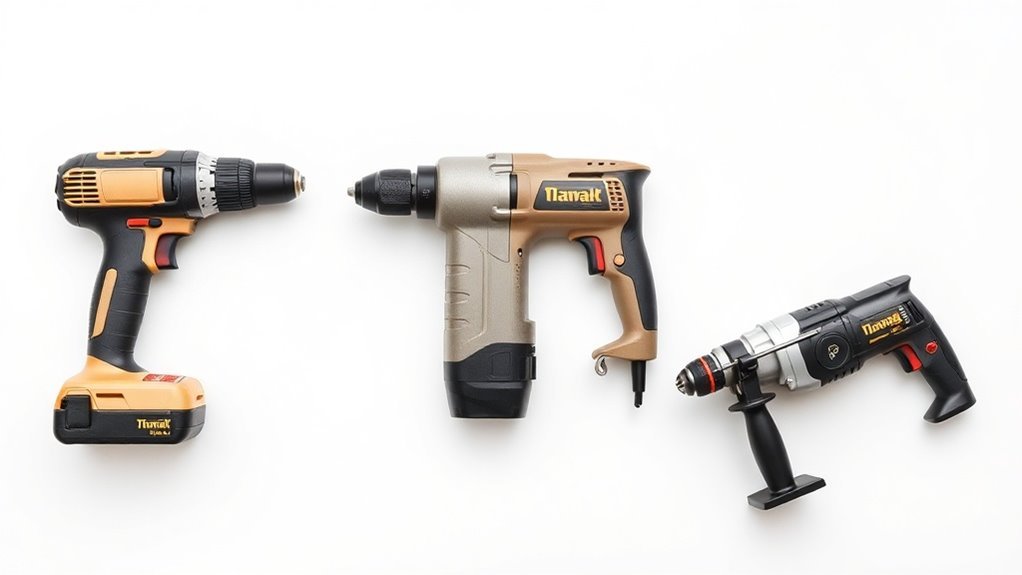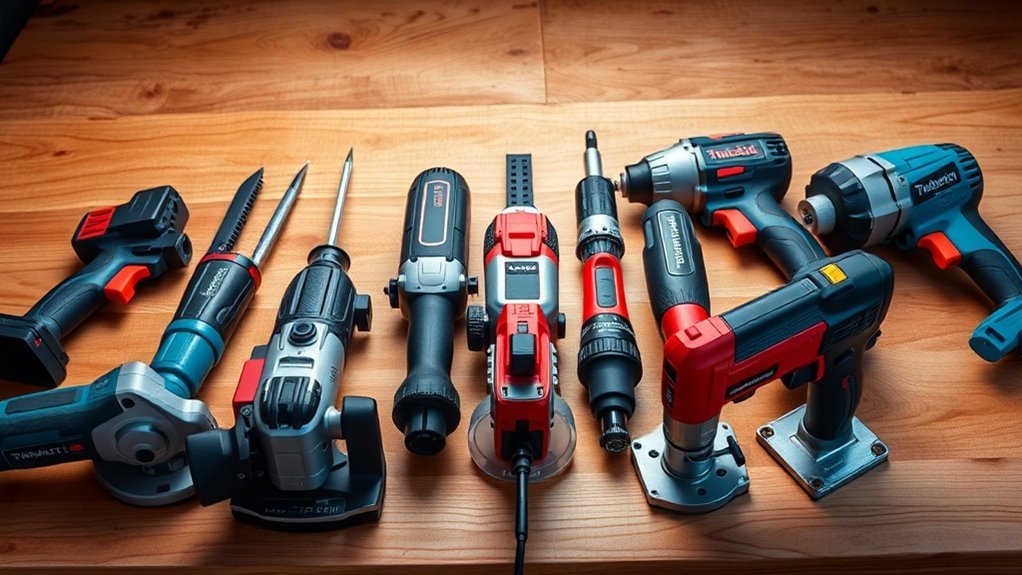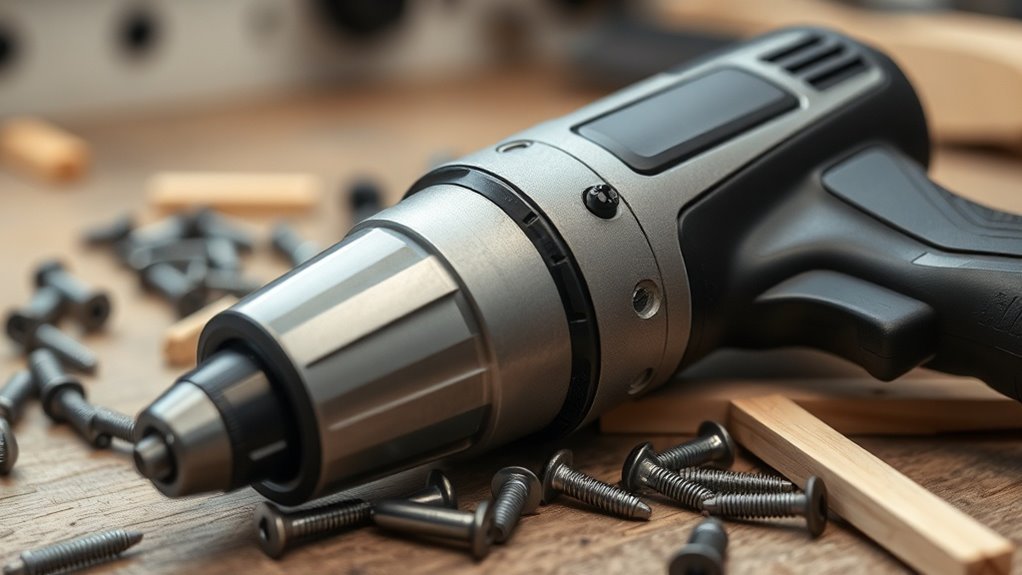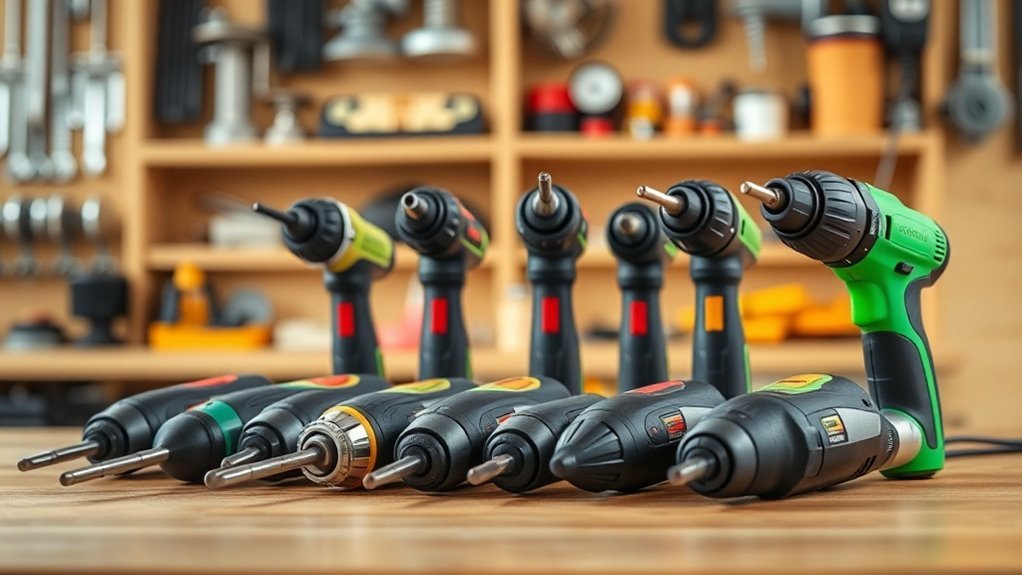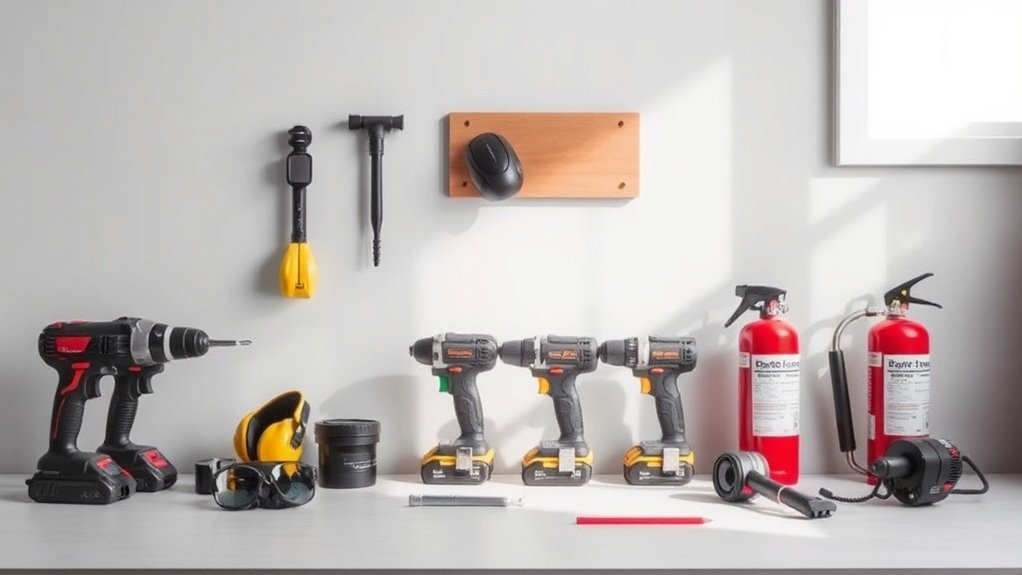How to Reduce Noise and Vibration While Using Power Tools
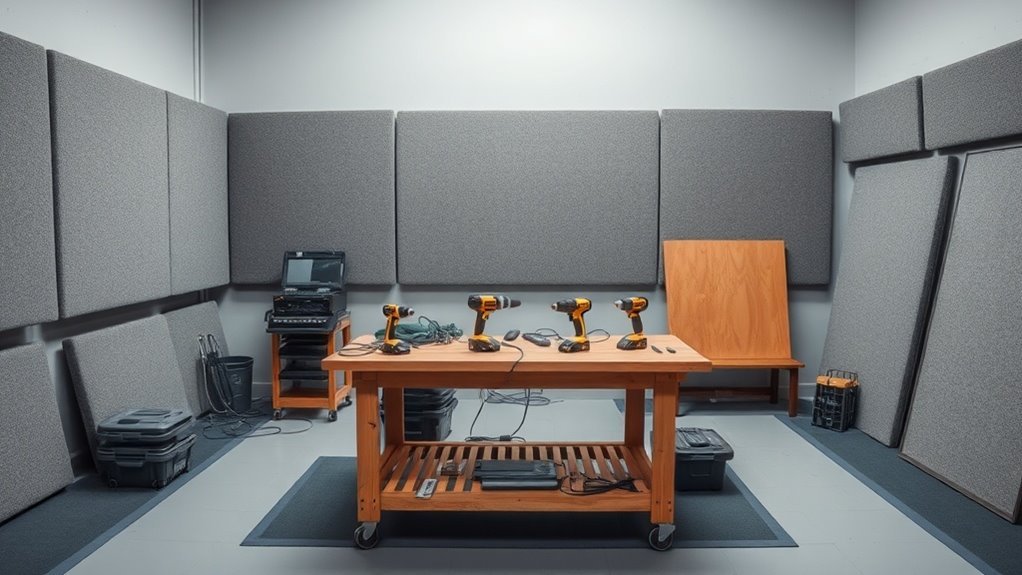
To reduce noise and vibration while using power tools, consider using battery-operated or electric models that feature quieter motors. Hand tools can also be a great option for less noise. Implement soundproofing techniques like acoustic panels and seal gaps to minimize sound leakage. Don’t forget to maintain your tools to keep them running smoothly. By applying these strategies, you’ll create a more comfortable workspace and guarantee safety. You might find more useful tips to enhance your experience.
Key Takeaways
- Choose battery-operated or electric tools over gas-powered ones for quieter operation and reduced vibration levels.
- Utilize hand tools when possible, as they generally produce less noise than power tools.
- Incorporate vibration dampening mats and anti-vibration gloves to enhance comfort and minimize the impact of vibrations.
- Implement soundproofing measures, such as acoustic panels and soundproof curtains, to absorb noise in the workspace.
- Schedule noisy tasks during designated quiet hours and communicate with neighbors to maintain good relationships.
Understanding Noise and Vibration in Power Tools
When you use power tools, it’s vital to understand how noise and vibration can impact both your work and your well-being.
Prolonged exposure to high noise levels can lead to hearing loss, while excessive vibration can cause discomfort and long-term injuries, such as hand-arm vibration syndrome. You mightn’t notice these effects immediately, but they accumulate over time.
Prolonged exposure to loud noises and vibrations can silently harm your health, leading to serious injuries over time.
That’s why it’s important to be aware of the decibel levels your tools generate and the vibrations they produce. Finding ways to minimize these elements won’t only enhance your comfort but also boost your efficiency. Additionally, ensuring that you wear appropriate safety gear can help mitigate some of the risks associated with noise and vibration exposure.
Keep in mind that your workspace setup can also influence how much noise and vibration you experience, so pay attention to your environment while you work.
Choosing the Right Tools for Reduced Noise
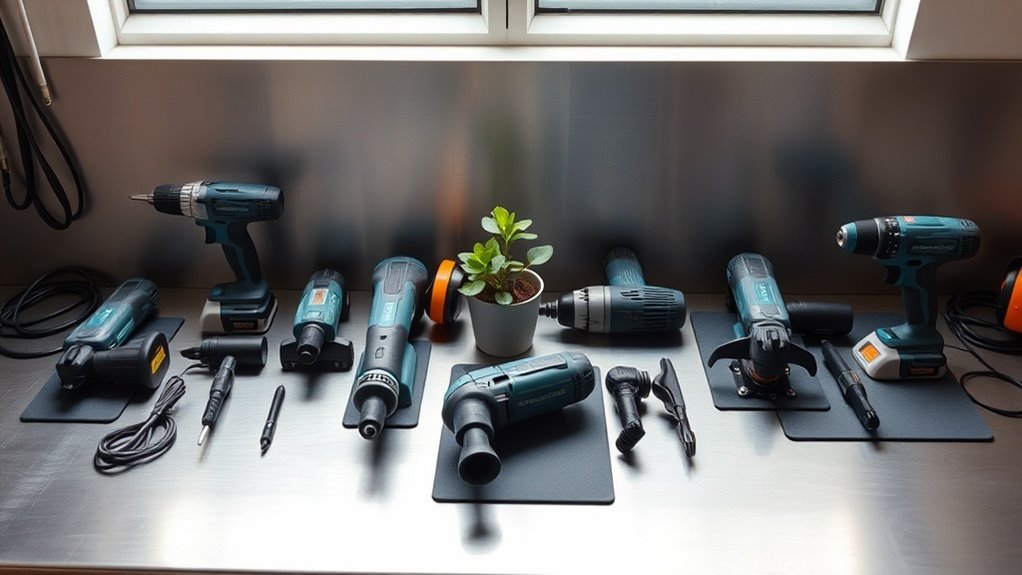
Finding the right tools can make a significant difference in reducing noise levels during your projects. Start by opting for battery-operated or electric tools instead of gas-powered ones, as they tend to be quieter.
Look for models specifically designed with noise reduction features, such as quieter motors and sound-dampening materials. A router with a low-noise rating or a drill with a well-designed gearbox can make your work environment much more pleasant.
Also, consider using hand tools when feasible, as they often produce less noise than power tools.
Finally, always check user reviews to see what others have experienced regarding noise levels. By selecting wisely, you can create a more comfortable and quieter workspace.
Implementing Soundproofing Techniques
To effectively reduce noise from your power tools, it’s important to implement soundproofing techniques.
You can use acoustic panels to absorb sound, install soundproof curtains for extra insulation, and seal any gaps or cracks to prevent noise leakage.
These simple steps can make a noticeable difference in your workspace.
Use Acoustic Panels
Although it might seem intimidating, incorporating acoustic panels into your workspace can greatly reduce noise levels and enhance the overall sound quality.
These panels are designed to absorb sound waves, minimizing echo and preventing sound from scattering. You don’t need to cover every wall; strategic placement around machinery or workstations will help.
When selecting panels, consider materials like foam or fabric-covered options, which are effective in dampening noise.
Installing them is straightforward—just mount them on walls or hang them from the ceiling. This simple step can create a quieter environment, allowing you to focus better while using power tools.
Plus, it makes your workspace more comfortable, turning it into a more enjoyable area for your projects.
Install Soundproof Curtains
If you’re looking for an effective way to reduce noise while working with power tools, installing soundproof curtains can be a game changer. These curtains are designed to absorb and block sound, creating a quieter workspace. They’re especially beneficial in garages or home workshops where noise can disturb family or neighbors.
Here’s a simple breakdown of their benefits:
| Benefit | Description | Impact |
|---|---|---|
| Noise Absorption | Reduces sound reverberation | Creates a quieter space |
| Versatility | Available in various styles | Fits your décor |
| Easy Installation | Simple to hang or remove | Quick setup |
Seal Gaps and Cracks
After installing soundproof curtains, the next step in creating a quieter environment is sealing gaps and cracks. These openings can let sound seep in, diminishing your efforts to reduce noise.
Start by inspecting door frames, windows, and baseboards for any visible spaces. Use weatherstripping or caulk to fill these gaps effectively.
Don’t forget to check outlets or light switches too; they often harbor small cracks that can amplify noise. For larger openings, consider using acoustic foam or soundproofing panels.
Utilizing Vibration Dampening Accessories
Vibration dampening accessories can greatly enhance your experience with power tools by minimizing unwanted vibrations and improving precision.
By using these accessories, you’ll notice a decrease in fatigue during extended use, allowing for more accurate and controlled work.
Look for rubber or foam pads, vibration dampening mats, and anti-vibration gloves to help absorb shocks. These accessories reduce the impact on your hands and arms, making your tasks not only more comfortable but safer as well.
Additionally, using specialized attachments and handles designed for vibration reduction can considerably improve your tool’s performance. It’s also essential to consider ergonomic handle design as it plays a vital role in reducing strain during prolonged use.
Make sure to invest in quality options that suit your specific tools and projects to fully reap the benefits of these dampening accessories.
Maintaining Your Tools for Optimal Performance
To keep your power tools running smoothly and efficiently, regular maintenance is vital.
Start by cleaning your tools after each use to remove dust and debris that can cause wear. Check and replace worn-out or damaged parts promptly to prevent further issues.
Lubricate moving components according to the manufacturer’s guidelines; a little oil can go a long way in reducing friction and noise. Confirm blades and bits are sharp and in good condition to improve performance and minimize vibration. Regularly check for rust to ensure your tools remain in top shape.
Store your tools properly to avoid damage from moisture or extreme temperatures.
Performing Work in Designated Quiet Hours
When you’re planning your projects, it’s essential to be aware of local noise regulations.
Timing your work to align with designated quiet hours can help you avoid conflicts with neighbors.
Plus, considering their peace can make your work environment more pleasant for everyone.
Local Noise Regulations
While you’re keen to tackle your project, it’s essential to be mindful of local noise regulations, especially during designated quiet hours.
These regulations often vary by location, so take a moment to check what’s enforced in your area. Ignoring these rules can lead to fines, complaints from neighbors, and even interruptions to your work.
Typically, quiet hours are set in the early morning or late evening, when residences are most vulnerable to disturbances. Make sure to plan your tool use accordingly, opting for quieter methods or tools during these times.
Practicing respect for these regulations not only helps maintain community relations but also creates a better work environment for you and your neighbors. Your dedication to thoughtful practices speaks volumes.
Timing Your Projects
Respecting local noise regulations is just the first step in ensuring your project runs smoothly.
Timing your work is equally essential, especially when it comes to minimizing disruption. By planning your projects during designated quiet hours, you can keep things peaceful for everyone around you.
Here are three tips to help you effectively time your projects:
- Check Local Guidelines: Determine the hours when noise is least disruptive in your area, typically early mornings or late afternoons.
- Plan Ahead: Organize your tasks so that you tackle the loudest jobs during those quieter times.
- Work Efficiently: Prepare all materials beforehand to maximize your productivity during those designated hours, minimizing the time you need to use power tools.
With these strategies, you’ll complete your work faster and with less disruption.
Neighbor Consideration Tips
Being considerate of your neighbors is essential, especially when you’re working during designated quiet hours.
Make sure you check local regulations regarding noise restrictions to avoid disturbing those around you. If possible, try scheduling your more demanding tasks during times when neighbors are likely to be out or not at home.
It’s also helpful to communicate with them about your plans; a simple heads-up can go a long way. You might consider using quieter tools or techniques to minimize noise.
Even wearing ear protection can help you keep your sound output to a minimum. Remember, a little thoughtfulness can foster a good relationship with your neighbors and keep your projects from becoming a source of tension.
Exploring Electric and Battery-Powered Alternatives
How can we effectively tackle noise and vibration issues in power tools? One effective solution is exploring electric and battery-powered alternatives.
These tools typically generate less noise and vibration compared to their gas-powered counterparts, making them a great option for reducing disturbances while you work.
Electric and battery-powered tools produce significantly less noise and vibration than gas-powered ones, minimizing worksite disturbances.
Here are three options to evaluate:
- Electric Saws: Quiet and efficient, they cut through materials with minimal noise.
- Cordless Drills: Battery-powered models provide freedom of movement without the loud rumble of gas engines.
- Electric Sanders: Designed for smooth finishes, they operate quietly and reduce hand fatigue due to less vibration. Additionally, many of these electric alternatives utilize brushless motors that enhance their efficiency and performance.
Adopting Proper Techniques and Body Posture
While using power tools can be exciting, adopting proper techniques and body posture is essential for minimizing noise and vibration exposure.
Start by confirming a firm and stable stance. Keep your feet shoulder-width apart and bend your knees slightly, which helps absorb vibrations. Use both hands to grip tools securely, allowing you to maintain control and reduce unnecessary force.
Try to keep your wrists straight; awkward angles can increase stress and vibration transfer. When possible, use tool attachments designed to dampen noise or vibration. Additionally, ensure that your grip and posture align with secure grip techniques, as improper handling can lead to increased exposure to vibrations.
Take regular breaks to rest your hands and avoid fatigue, as this can heighten sensitivity to vibrations. By incorporating these techniques, you’ll not only enhance your comfort but also confirm a safer work environment.
Questions
Can Noise-Canceling Headphones Help While Using Power Tools?
Yes, noise-canceling headphones can help while using power tools by reducing ambient noise, allowing you to focus better. Just make sure they’re comfortable and safe to wear in your working environment for maximum effectiveness.
What Is the Impact of Weather on Tool Noise Levels?
Weather can markedly impact tool noise levels. Higher humidity often amplifies sound, while cold weather can make materials less flexible, increasing vibration. So, outdoor conditions can change how loud and disruptive your tools feel.
Are There Specific Power Tools Known for Being Quieter?
Some specific power tools known for being quieter include electric scissors, screwdrivers, and certain models of cordless drills. You’ll find these tools reduce sound without sacrificing performance, making your projects more pleasant to work on.
Can Regular Maintenance Reduce Noise and Vibration Significantly?
Yes, regular maintenance can greatly reduce noise and vibration. Checking and lubricating moving parts, tightening loose components, and replacing worn-out elements guarantee tools run smoothly, leading to quieter and less vibrating operation while you work.
How Do Neighbors Typically React to Noise From Power Tools?
Studies show about 70% of neighbors find power tool noise disruptive. They typically react with irritation or annoyance, especially if the noise persists. So, it’s a good idea to be considerate of your timing and volume.
Conclusion
In the end, creating a peaceful workspace can make all the difference. By choosing the right tools, enhancing your setup, and practicing good maintenance, you’ll find that the symphony of power tools can be much more harmonious. Embracing quieter alternatives and adopting thoughtful techniques will not only ease the auditory landscape but also improve your overall experience. So, let’s keep the racket to a minimum and enjoy the soothing art of craftsmanship!


